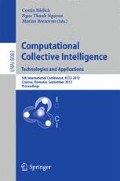Abstract
In this paper we describe an alignment system that takes English-Romanian parallel sentences (bitexts) and aligns them at their content-word level. A syntactic feature approach combined with a dictionary lookup is used as primary technique to perform word alignments. Other used methods take into account local word grouping or the nearest aligned neighbors approach to filter between many-to-many word alignments. Building an alignment system at the word level, one can use it in the creation of new resources, for example collections of parallel sequences of texts in the two languages based on which translation schemes could be learned.
Access this chapter
Tax calculation will be finalised at checkout
Purchases are for personal use only
Preview
Unable to display preview. Download preview PDF.
References
Alhazov, A., Boian, E., Cojocaru, S., Rogozhin, Y.: Modelling Inflections in Romanian Language by P Systems with String Replication. The Computer Science Journal of Moldova 17(2), 160–178 (2009)
Colhon, M.: Language Engineering for Syntactic Knowledge Transfer. Computer Science and Information Systems Journal (ComSIS) 9(3), 1231–1248 (2012)
Cristea, D., Simionescu, R., Haja, G.: Reconstructing the Diachronic Morphology of Romanian from Dictionary Citations. In: Proceedings of Conference on Language Resources and Evaluation, LREC 2012 (2012)
Holmqvist, M.: Heuristic word alignment with parallel phrases. In: Proceedings of the Seventh Conference on International Language Resources and Evaluation, LREC 2010 (2010)
Ma, X.: Champollion: A Robust Parallel Text Sentence Aligner. In: 5th International Conference on Language Resources and Evaluation, LREC 2006, pp. 489–492 (2006)
Manning, C., Schütze, H.: Foundations of Statistical Natural Language Processing. MITPress, Cambridge (2003)
Munteanu, D., Marcu, D.: Improving Machine Translation Performance by Exploiting Comparable Corpora. Computational Linguistics 31(4), 477–504 (2005)
Santos, A.: A survey on parallel corpora alignment. In: MI-Star 2011, Braga, Portugal (2011)
Ştefănescu, D.: Intelligent Information Extraction of Multilingual Corpora. PhD Thesis. Romanian Academy. Research Institute for Artificial Intelligence (2010)
Ştefănescu, D., Ion, R., Hunsicker, S.: Hybrid Parallel Sentence Mining from Comparable Corpora. In: Proceedings of the 16th Conference of the European Association for Machine Translation, EAMT 2012, pp. 137–144 (2012)
Tufiş, D., Ion, R., Ceauşu, A., Ştefănescu, D.: Combined word alignments. In: Proceedings of the ACL Workshop on Building and Using Parallel Texts, Ann Arbor, pp. 107–110. Association for Computational Linguistics (June 2005)
Tufiş, D.: From Word Alignment to Word Senses, via Multilingual Wordnets. The Computer Science Journal of Moldova - CSJM 14(1), 3–33 (2006)
Tufiş, D., Ion, R., Ceauşu, A., Ştefănescu, D.: Improved Lexical Alignment by Combining Multiple Reified Alignments. In: Proceedings of the 11th Conference of the European Chapter of the Association for Computational Linguistics - EACL 2006, Trento, Italy, pp. 153–160. Association for Computational Linguistics (April 2006) ISBN 1-9324-32-61-2
Véronis, J., Langlais, P.: Evaluation of parallel text alignment systems. The ARCADE project. In: Véronis, J. (ed.) Parallel Text Processing, pp. 369–388. Kluwer Academic Publishers, The Netherlands (2000)
Yamada, K., Knight, K.: A syntax-based statistical translation model. In: 39th Meeting of the Association for Computational Linguistics ACL 2001, Toulouse, France, pp. 523-530 (2001)
Author information
Authors and Affiliations
Editor information
Editors and Affiliations
Rights and permissions
Copyright information
© 2013 Springer-Verlag Berlin Heidelberg
About this paper
Cite this paper
Colhon, M. (2013). Automatic Lexical Alignment between Syntactically Weak Related Languages. Application for English and Romanian. In: Bǎdicǎ, C., Nguyen, N.T., Brezovan, M. (eds) Computational Collective Intelligence. Technologies and Applications. ICCCI 2013. Lecture Notes in Computer Science(), vol 8083. Springer, Berlin, Heidelberg. https://doi.org/10.1007/978-3-642-40495-5_27
Download citation
DOI: https://doi.org/10.1007/978-3-642-40495-5_27
Publisher Name: Springer, Berlin, Heidelberg
Print ISBN: 978-3-642-40494-8
Online ISBN: 978-3-642-40495-5
eBook Packages: Computer ScienceComputer Science (R0)

